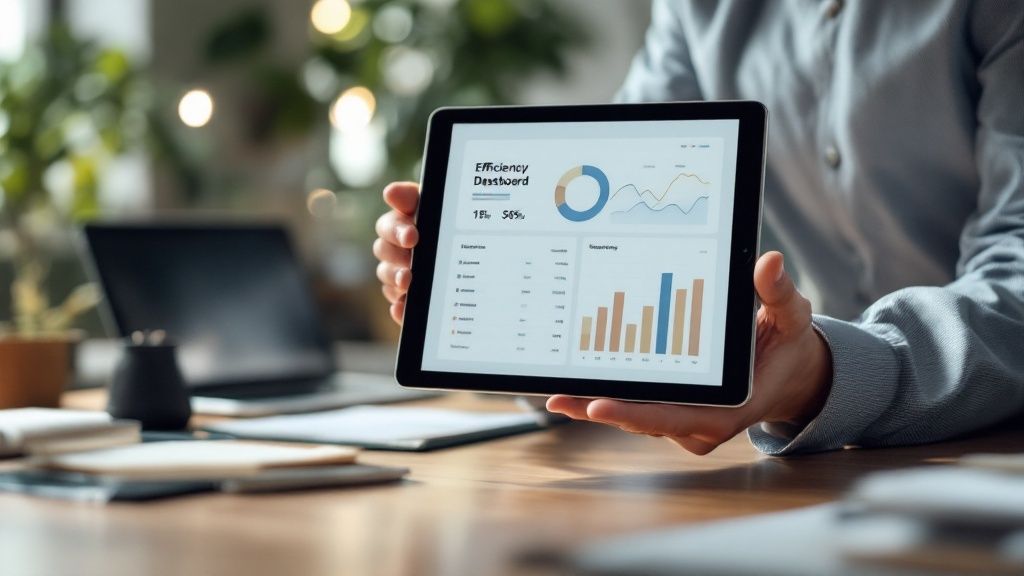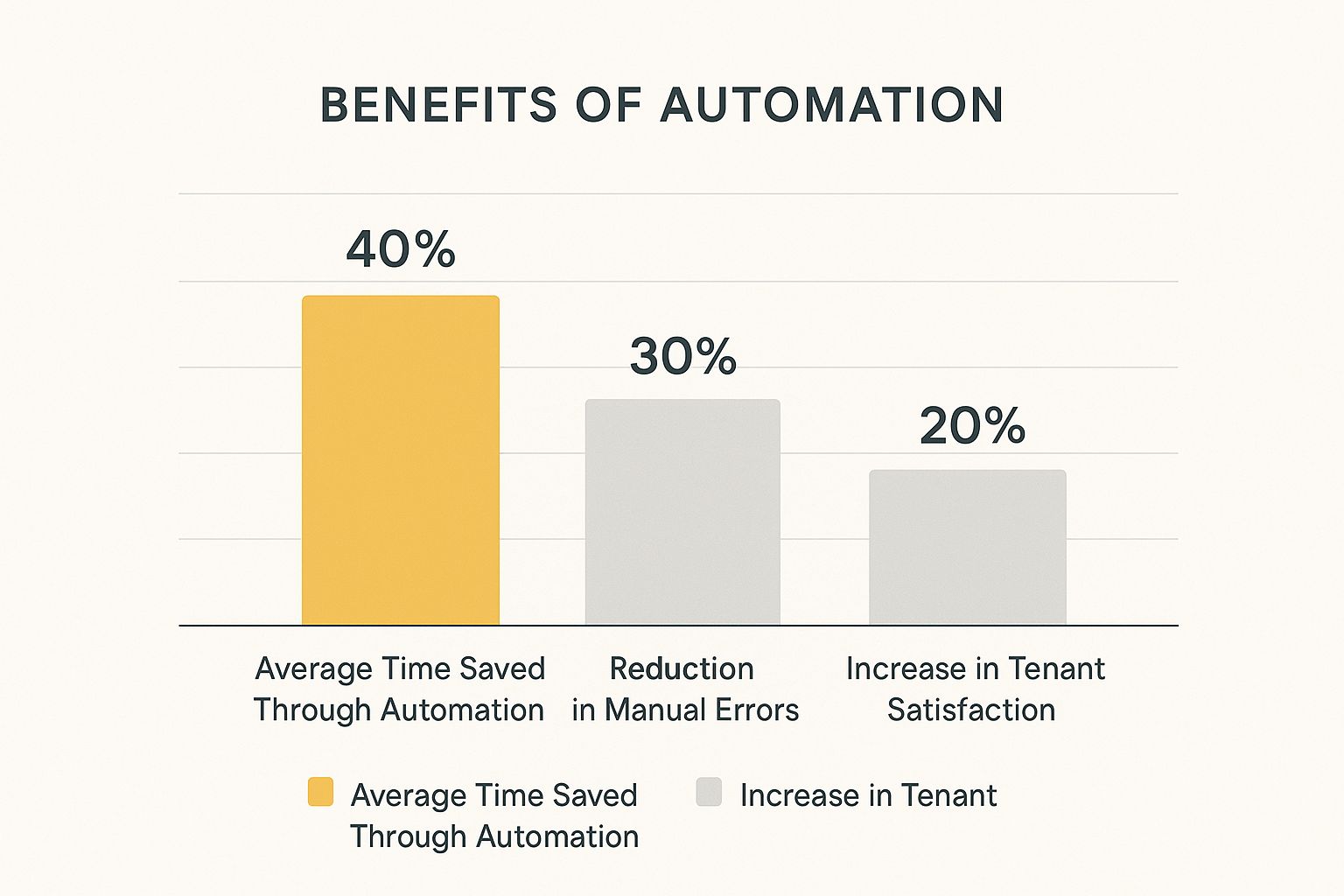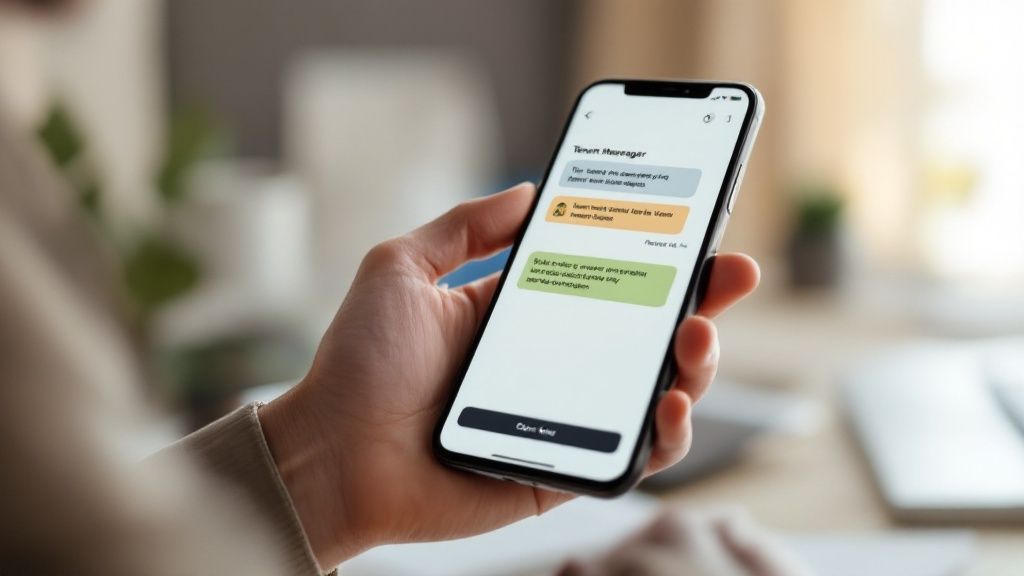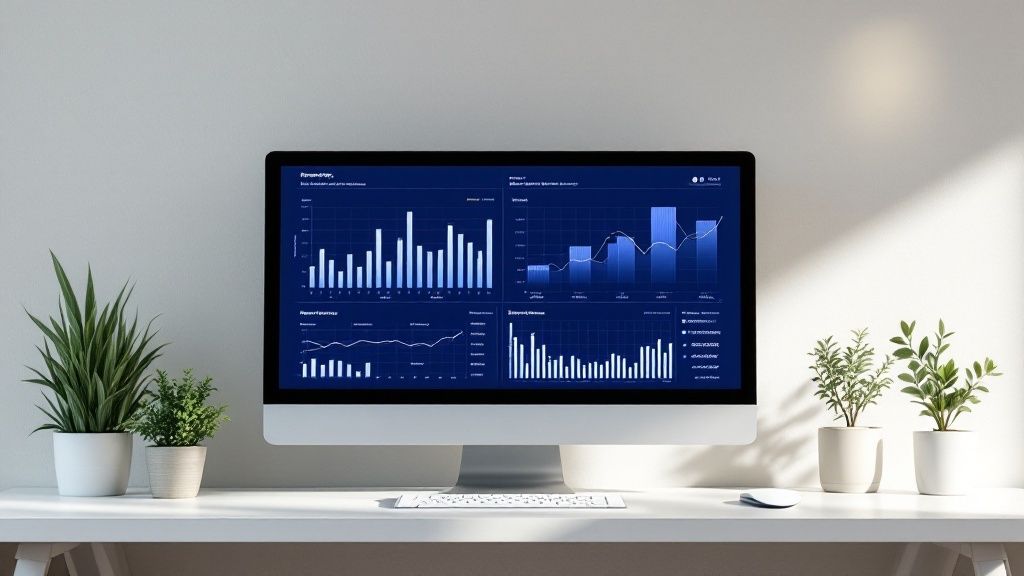The Evolution of Property Management in Australia

The Australian property management scene is changing. Keeping up with the competition now demands efficiency. This shift comes from several factors, including the market's size and growth, what tenants expect, and the rise in global investment. These forces are pushing property management in a new direction.
Market Growth and International Investment
The Australian property management market is booming. In 2024, it hit USD 8.1 billion. It's predicted to grow at a CAGR of 2.98%, hitting USD 11.0 billion by 2033. This growth comes from higher demand for rentals, rapid urbanization, and growing real estate investment, especially from overseas. Learn more about the Australia Property Management Market. International investors often prefer to hire property managers, further boosting demand. This global capital influx highlights the growing importance of efficient property management for larger, more diverse portfolios.
Changing Tenant Expectations and Competitive Pressures
Tenant expectations are also changing. Renters now want quicker responses, clear communication, and easy-to-use digital tools. This requires moving away from slower, traditional management practices. Plus, the Australian property management sector is getting more competitive. Agencies are fighting for market share, and those offering top-notch service and efficiency have the edge. This competitive environment further stresses the need for streamlined operations and optimized workflows. For tips on improving operational efficiency, see this helpful resource: Improve Operational Efficiency.
The Failure of Traditional Approaches
Traditional property management, often using manual processes and outdated systems, can't keep up with these changes. These old methods are slow, prone to mistakes, and lack the flexibility needed in today's market. Agencies sticking to these old ways struggle to stay profitable and competitive. Embracing technology and fresh strategies is now essential for success in the Australian property management industry. The future of property management is all about efficiency, and those who adapt will succeed.
Transforming Operations Through Proptech Solutions

This infographic illustrates the potential of proptech solutions. It shows how these technologies can lead to a 40% average time savings through automation, a 30% reduction in manual errors, and a 20% boost in tenant satisfaction. These improvements streamline operations and create happier tenants.
This section explores how top Australian property managers are using technology to revolutionize their work. It goes beyond simple software upgrades, examining real-world examples of agencies using AI, automation, and mobile solutions to handle bigger portfolios with less effort. Doing more with less is key in today’s competitive market. Technology is reshaping the Australian property sector. The use of Artificial Intelligence (AI) is projected to significantly impact property management efficiency by 2025, simplifying tasks like lease reviews and tenant communications. Explore this topic further.
Identifying The Right Proptech For Your Agency
Not every platform delivers equal results. Some offer great returns, while others create headaches. Careful evaluation is essential. Whether you run a small business or a large enterprise, this section helps you choose platforms that truly benefit your agency. We’ll look at practical strategies applicable to portfolios of any size.
-
AI-Powered Solutions: AI can automate tenant screening, lease analysis, and even predictive maintenance. This frees your team to focus on more important work.
-
Automation Tools: Automating rent collection, reminders, and reporting reduces administrative burdens and minimizes mistakes.
-
Mobile Solutions: Giving tenants and owners mobile access to information, communication channels, and service requests increases transparency and responsiveness.
Real-World Case Studies: Proptech In Action
Real-world examples show how these technologies produce measurable improvements. These case studies highlight the practical applications and tangible benefits of proptech in Australia, focusing on efficiency gains, reduced workload, and increased client satisfaction.
-
Case Study 1: A Melbourne agency implemented an AI-powered leasing platform. This resulted in a 25% reduction in lease processing time and a 15% increase in lease renewals.
-
Case Study 2: A Sydney property management firm adopted a mobile maintenance management system, leading to a 30% decrease in response times and a 20% reduction in maintenance costs.
To help illustrate the various options available, the table below compares several popular proptech solutions in the Australian market.
To assist Australian property managers in evaluating their technology options, we've compiled a comparison table. This table showcases key features, pricing, and suitability for various portfolio sizes.
| Software Solution | Key Features | Monthly Cost | Ideal Portfolio Size | Integration Capabilities | Australian Market Presence |
|---|---|---|---|---|---|
| Example Software 1 | Lease management, tenant communication, maintenance tracking | $199 | 50-200 | Accounting software, CRM | Strong |
| Example Software 2 | AI-powered tenant screening, automated reporting | $499 | 200+ | Payment gateways, property portals | Growing |
| Example Software 3 | Mobile inspections, digital signatures | $99 | <50 | Limited | Emerging |
This table provides a snapshot of the diverse proptech landscape. It's essential to research each solution thoroughly to determine the best fit for your agency's specific needs and budget.
Practical Implementation For Australian Agencies
Implementing these technologies requires a strategic, market-specific approach. This involves understanding local regulations, tenant expectations, and the unique challenges faced by Australian property managers. We'll cover best practices and adaptable templates. Effective implementation is crucial for maximizing the potential of these advancements.
-
Start Small: Begin with one or two solutions that address your biggest challenges.
-
Train Your Team: Invest in training so your team can effectively use the new technologies.
-
Monitor And Adjust: Regularly monitor performance and adjust your strategy as needed.
By focusing on the right technologies and implementing them strategically, Australian property managers can achieve significant efficiency gains, improve client satisfaction, and stay ahead of the curve. This proactive approach empowers property managers to optimize their operations and thrive in Australia's competitive property market.
Revolutionizing Financial Management for Faster Cash Flow

The Australian property management landscape is witnessing a significant shift in financial practices. Progressive agencies are moving away from traditional trust accounts and embracing direct payment systems. This change offers substantial benefits, especially in reducing administrative overhead and boosting cash flow. Let's explore how these systems are reshaping property management efficiency.
Streamlining Transactions With Direct Payment Systems
Direct payment systems automate rent collection, simplify reconciliation, and offer real-time insights into financial transactions. This automation eliminates the complexities often associated with managing trust accounts, freeing up property managers to focus on other essential tasks. Integrating these systems with accounting software like Xero can further enhance efficiency. Automating processes is a key strategy for boosting efficiency. For more insights into automation, check out this helpful article: property management automation.
Evaluating Financial Management Solutions in the Australian Context
Choosing the right financial management solution requires careful consideration. Key factors include compliance with Australian regulations, integration capabilities with existing systems, and robust security features to safeguard sensitive financial data. A well-chosen system can drastically improve a property management agency's operational efficiency.
-
Compliance: The selected platform must adhere to all relevant Australian financial regulations and reporting standards.
-
Integration: Seamless integration with existing accounting software and property management platforms is crucial for optimized efficiency.
-
Security: Strong security measures are paramount for protecting financial data and ensuring compliance with privacy regulations.
Addressing Late Payments and Maintaining Positive Tenant Relationships
Late rent payments can significantly impact an agency's cash flow. However, proactive communication and clearly defined payment policies can help mitigate these issues. Implementing automated payment reminders and offering flexible payment options can encourage timely payments while fostering positive tenant relationships. This benefits both the agency and its tenants.
Efficiency in Australian Property Management: A 2024 Trend
Efficiency is paramount in Australia's competitive property management market. The 2024 ranking of Australia's Stellar Agencies revealed a compelling trend: the fastest-growing agencies are increasingly adopting platforms that bypass traditional trust accounts in favor of automated direct payment systems. Agencies operating without trust accounts achieved the highest average efficiency score, managing approximately 142.35 properties per property manager. This figure is significantly higher than agencies using conventional payment systems. Find more detailed statistics here.
Choosing the Right Platform: Key Considerations for Australian Property Managers
Selecting the right payment platform involves evaluating several crucial factors. These include transaction fees, integration capabilities with existing systems, and user-friendliness for both property managers and tenants. The right platform is a strategic investment in long-term efficiency.
-
Transaction Fees: Carefully assess transaction fees and select a platform offering competitive rates without sacrificing essential features.
-
Integration: Seamless integration with existing property management software is essential for maximizing efficiency and preventing data silos.
-
User-Friendliness: The platform should be intuitive and easy to use for both property managers and tenants, encouraging adoption and streamlining payment processes.
By adopting modern financial management practices and carefully selecting the right tools, Australian property management agencies can significantly improve their efficiency, enhance cash flow reliability, and boost overall financial performance. This shift towards automation and streamlined processes positions agencies for continued success in a dynamic market.
Building a Maintenance System That Actually Works
Maintaining properties can be a real headache for property managers. This section dives into practical, proven maintenance systems used by Australian property managers to boost response times and cut costs. We're skipping the theory and focusing on what's working in the real world.
Creating a Reliable Contractor Network
A solid contractor network is the backbone of efficient maintenance. It's not just about having a contact list; it's about building relationships with reliable tradespeople who prioritize your properties.
-
Negotiated Rates and Priority Service: Pre-negotiating rates and securing priority service agreements means faster response times and predictable costs, benefiting both you and your owners.
-
Specialization is Key: Diversify your network with specialists in various trades, like plumbing, electrical, and carpentry. Having the right experts on hand is essential for handling a range of maintenance needs.
-
Regular Communication: Keeping in touch with your contractors, even when there's no specific job, strengthens relationships and reinforces your expectations for quality and responsiveness.
Implementing Digital Workflows
Ditch the endless phone calls and emails. Digital workflows streamline the entire maintenance process, from the initial request to job completion.
-
Tenant Self-Service Portals: Empower tenants to submit maintenance requests directly through a portal. This eliminates phone calls and ensures thorough documentation. Software like PropertyMe provides these features.
-
Automated Updates and Notifications: Keep everyone in the loop with automated updates on request status, scheduled repairs, and completion notifications. Transparency builds trust and reduces follow-ups.
-
Integrated Communication: Connecting your system directly with your contractors enables seamless communication, cutting out the middleman and accelerating response times.
To demonstrate the improvements that can be achieved, let's take a look at a statistical comparison:
Property Management Efficiency Metrics Comparison
Statistical comparison of operational efficiency between traditional and technology-enhanced property management approaches in Australia
| Efficiency Metric | Traditional Management | Tech-Enhanced Management | Percentage Improvement | Industry Benchmark |
|---|---|---|---|---|
| Average Response Time (hours) | 48 | 24 | 50% | 24-36 |
| Maintenance Cost per Property (AUD/year) | $2,500 | $2,000 | 20% | $1,800-$2,200 |
| Tenant Satisfaction (1-5 scale) | 3.5 | 4.2 | 20% | 4.0 |
| Contractor Response Rate (%) | 70 | 90 | 29% | 85% |
The table above showcases how integrating technology can greatly improve key metrics in property management. While the tech-enhanced approach already outperforms traditional methods in most areas, aiming for the industry benchmark will further optimize results.
Preventative Maintenance Programs: Saving Money in the Long Run
Preventative maintenance is an investment, not a cost, as it reduces the need for expensive emergency repairs. This proactive approach tackles potential problems before they become major headaches.
-
Regular Inspections: Scheduled inspections can catch minor issues early, preventing them from turning into costly repairs down the road.
-
Seasonal Maintenance Checks: Implement seasonal checks to prepare properties for weather changes. For example, checking gutters before heavy rain can prevent water damage.
-
Tenant Education: Educate tenants about basic property upkeep, like changing air filters and reporting small problems promptly. Sharing this responsibility can significantly reduce maintenance needs.
Leveraging Tenant Portals and Inspections
Tenant portals and well-planned inspections are valuable tools for proactive maintenance. They allow for early problem identification and prevent small issues from escalating.
-
Tenant-Reported Issues: Tenant portals make it easy for tenants to report problems immediately, allowing for quicker action.
-
Detailed Inspection Reports: Standardized inspection reports help document property condition, track maintenance needs, and identify recurring issues. Tools like HappyCo can assist with this.
-
Data-Driven Decisions: Analyzing inspection data highlights trends and areas for improvement in your maintenance strategies. This data-driven approach optimizes processes and cuts costs over time.
By using these strategies, Australian property managers can build maintenance systems that are efficient, boost tenant satisfaction, and save property owners money. This proactive maintenance approach is crucial for maximizing property value and fostering positive tenant relationships.
Mastering Tenant Communication That Saves Time

Effective communication is essential for successful property management. This section explores how top property managers are building communication systems that enhance tenant satisfaction and save valuable time. They're moving beyond basic tools and creating comprehensive communication strategies.
Multi-Channel Communication: Finding the Right Balance
Reaching tenants through various platforms is key. However, finding the right mix of communication channels is crucial to avoid overwhelming tenants or creating extra work.
-
Targeted Approach: Consider tenant demographics and preferences. Younger tenants may prefer SMS or app notifications, while others might prefer email or phone calls.
-
Consolidated Platform: Manage all communication from a central platform. This streamlines messaging and ensures consistency. Tools like OnSilent can efficiently manage calls and voicemails.
-
Automated Messaging: Automate routine communications like rent reminders, inspection notices, and maintenance updates.
Onboarding: Setting the Stage for Smooth Communication
Tenant onboarding sets the tone for the entire tenancy. Clear communication from the start minimizes misunderstandings and prevents repetitive questions down the line.
-
Welcome Packets: Provide detailed welcome packets with essential information about the property, lease terms, and contact details.
-
Online Resources: Create an online portal with FAQs, how-to guides, and contact information readily available for tenants.
-
Initial Check-in: A thorough initial check-in addresses questions and establishes clear expectations.
Data-Driven Communication: Anticipating Tenant Needs
Data-driven communication goes beyond simply reacting to issues. It involves analyzing tenant data to anticipate needs and proactively address potential problems.
-
Tenant Surveys: Regularly gather tenant feedback through surveys to assess satisfaction and identify areas for improvement.
-
Maintenance Request Analysis: Track maintenance requests to spot recurring issues and fix underlying problems.
-
Personalized Communication: Use tenant data to personalize communications, offering relevant information and tailored solutions.
Templates and Automation: Efficiency Without Losing the Personal Touch
Automation doesn't have to be impersonal. Well-crafted templates and automated workflows can save time while maintaining a personal connection.
-
Personalized Templates: Create email and SMS templates for common communications. Personalize them with tenant names and property details.
-
Automated Workflows: Use automated workflows for tasks like sending rent reminders, scheduling inspections, and following up on maintenance requests.
-
Example Workflow: When a tenant submits a maintenance request, the system automatically acknowledges the request, notifies the relevant contractor, and keeps the tenant updated on progress.
By implementing these strategies, property managers can create efficient and effective communication systems that improve tenant satisfaction. This proactive approach strengthens tenant relationships, reduces administrative burdens, and frees up time for other important tasks. Focusing on clear, timely, and personalized communication benefits everyone involved.
Navigating Compliance Without the Administrative Nightmare
Australia's complex regulatory landscape presents significant challenges for property managers. However, forward-thinking agencies are adopting efficient systems to maintain compliance without being overwhelmed by administrative tasks. This section provides practical strategies for developing effective compliance systems that protect your business and minimize wasted resources.
Automating Compliance Tracking Across Jurisdictions
Successfully managing the intricacies of Australian property law requires staying informed about the diverse regulations across different states and territories. This can be a major administrative hurdle, but digital tools provide a means to automate compliance tracking and ensure consistency across your entire property portfolio.
-
Centralized Compliance Database: A central system containing all relevant legislation and regulatory updates for each jurisdiction allows property managers quick access to the correct information.
-
Automated Notifications: Setting up automatic alerts for legislative changes ensures your agency stays up-to-date and adapts to new requirements promptly. This proactive approach helps prevent compliance breaches and potential fines.
-
Integration with Property Management Software: Integrating your compliance database with your current property management software creates a streamlined workflow, eliminating manual cross-referencing and reducing the possibility of errors.
Streamlining Documentation for Instant Accessibility
Maintaining accurate and easily accessible documentation is essential for compliance. Traditional paper-based methods are cumbersome and inefficient. Digital document management systems offer a far more effective approach.
-
Secure Cloud Storage: Cloud-based platforms offer secure storage and retrieval of all important documents, ranging from lease agreements to inspection reports. This ensures information is readily accessible from any location with internet access.
-
Automated Document Generation: Automating the creation of standard compliance documents, such as lease renewals and notices, saves considerable time and minimizes the chance of human error.
-
Digital Signatures: Implementing digital signatures accelerates document execution and reduces the reliance on physical paperwork, improving overall efficiency. OnSilent integrates with leading e-signature platforms, streamlining communication and documentation procedures.
Optimizing Inspection Protocols for Efficiency
Regular inspections are critical for compliance, but conventional inspection methods can be time-consuming. Modern agencies are using technology to streamline this process without sacrificing thoroughness.
-
Mobile Inspection Apps: Mobile apps empower inspectors to complete detailed reports on-site, incorporating photos and videos. This removes the need for manual data entry and lessens the risk of transcription errors.
-
Automated Scheduling and Reminders: Automating inspection scheduling and sending reminders to tenants minimizes no-shows and guarantees inspections are carried out promptly.
-
Integration with Compliance Databases: Linking your inspection app with your compliance database ensures inspections adhere to the latest regulatory requirements for each jurisdiction.
Real-World Examples: Compliance Efficiency in Action
Real-world examples illustrate how these strategies lead to tangible advantages for Australian property management agencies.
-
Example 1: A Queensland agency decreased its compliance-related administrative time by 40% after implementing a digital document management system.
-
Example 2: A Victorian agency boosted its inspection completion rate by 25% by adopting a mobile inspection app with automated scheduling and reminders.
By adopting these methods, property managers can establish robust and efficient compliance systems. This proactive approach safeguards your business from legal issues, minimizes administrative workloads, and enables your team to concentrate on other vital aspects of property management. Efficiency in compliance is not simply a desirable outcome, but a requirement for success in the ever-changing Australian property market.
Creating a Culture of Continuous Efficiency Improvement
Improving property management efficiency isn't just about adopting new software or automating tasks. It's about building a culture where continuous improvement is embedded in every part of your agency. This means going beyond simple metrics and creating a system where efficiency is valued by everyone. Let's explore how Australia's top agencies are making this happen.
Going Beyond Basic Efficiency Metrics
The properties-per-manager ratio is a good starting point, but it doesn't give you the full picture. Successful agencies are digging deeper, using data to find areas for improvement and track their progress. They're using more detailed metrics that truly reflect the complexities of property management in Australia.
-
Tenant Satisfaction Scores: Keeping tenants happy means lower turnover and fewer vacancies. Regular surveys and feedback systems can help you monitor tenant satisfaction.
-
Maintenance Response Times: Efficient maintenance keeps tenants happy and protects property values. Tracking how quickly maintenance issues are handled is crucial.
-
Financial Performance Metrics: Metrics like arrears rates, days-to-lease, and lease renewal rates offer important insights into financial efficiency. Analyzing this data can help you catch potential problems early.
-
Staff Turnover Rates: High staff turnover disrupts operations and impacts efficiency. Focusing on employee satisfaction and a positive work environment helps retain experienced staff.
Identifying Operational Bottlenecks with Existing Data
You probably already have the data you need to pinpoint operational bottlenecks. The key is analyzing it effectively.
-
Analyze Maintenance Request Data: Recurring maintenance issues at specific properties might point to larger problems. Fixing these could significantly reduce future costs.
-
Review Tenant Communication Logs: Identify frequently asked questions or common complaints. This can help you improve tenant onboarding and communication processes.
-
Track Time Spent on Various Tasks: Time tracking software like Toggl Track can show you where your team spends most of their time, highlighting tasks that could be automated or streamlined.
Implementing Team-Wide Improvement Initiatives
Improving efficiency is a team effort. Get everyone involved.
-
Regular Team Meetings: Discuss efficiency challenges and brainstorm solutions as a team. Encourage open communication and collaboration.
-
Incentivize Efficiency Improvements: Recognizing and rewarding contributions to efficiency creates a culture of continuous improvement.
-
Provide Training and Resources: Give your team the skills and tools they need to work efficiently. Regular training on new software and best practices can boost productivity.
Building Review Processes That Drive Ongoing Optimization
Continuous improvement means regular reviews and adjustments.
-
Regular Performance Reviews: Regularly review key efficiency metrics, ideally monthly or quarterly, to track progress and identify areas needing attention.
-
Process Audits: Periodically audit key operational processes to identify inefficiencies and areas for improvement.
-
Feedback Loops: Gather feedback from tenants, owners, and staff on how to improve efficiency. This real-world feedback is invaluable.
By focusing on these strategies, Australian property management agencies can create a culture of continuous improvement. It's not just about adopting new tech, but about fostering a mindset where efficiency is valued and constantly pursued. This positions agencies for long-term success in the competitive property management market.
Ready to improve your property management communication and save valuable time? OnSilent offers a smart voicemail and call management solution that streamlines communication, letting you focus on what matters most. Learn more about OnSilent and how it can benefit your agency.

